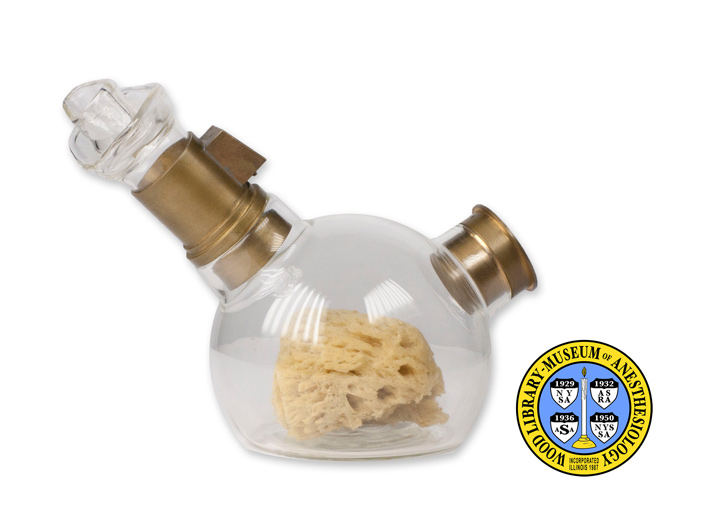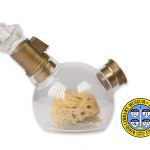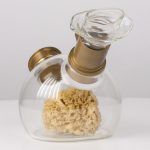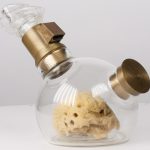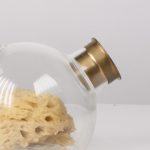Replica of Morton Inhaler
The first successful public demonstration of ether for surgical anesthesia occurred with an inhaler much like this one, at Massachusetts General Hospital on October 16, 1846. William Thomas Green Morton (1819-1868), a dentist in Boston Massachusetts, was the person who administered the ether on that historic occasion. The glass sphere contained an ether-soaked sponge; the patient inhaled the vapor through the mouthpiece. News of the event spread rapidly and within a year of his demonstration dozens of European inhalers had been invented and patented.
A booklet describing the replica, simply titled "The Morton Inhaler," explains that this replica "was made from the original description of its physical attributes...and of its measurements as furnished by the courtesy of the Massachusetts General Hospital. Reproduced by a modern instrument maker under the aegis of the Wood Library-Museum of Anesthesiology, the project was made feasible by a grant-in-aid from Ayerst Laboratories.
Catalog Record: Replica of Morton Inhaler
Access Key: aiml
Accession No.: 2010-07-27-1
Title: [Replica of the 1846 Morton ether inhaler].
Author: Morton, W. T. G. (William Thomas Green), 1819-1868.
Title variation: Alt Title
Title: Ayerst replica of the Morton inhaler.
Publisher: [S.l. : s.n., ca. 1965.]
Physical Description: 1 inhaler : glass, brass, leather ; 18 x 13 x 22 cm.
Subject: Ether, Ethyl.
Subject: Inhalers, Anesthesia.
Subject: Anesthesia, Inhalation.
Subject: Ether Controversy.
Subject: Morton, W. T. G. (William Thomas Green), 1819-1868.
Subject: Massachusetts General Hospital – history.
Note Type: General
Notes: Title from the WLM name for the replica.
Note Type: Physical Description
Notes: A glass inhaler consisting of a spherical glass body and brass accessories; A
natural sponge sits inside the spherical body; Protruding from different
sides of the sphere are two tubular openings; One opening is capped by a
removable brass cap, or stopper, approx. 3.5 cm in length; The other opening
is connected to a glass mouth-piece by a brass ‘tube’, approx. 6.5 cm in
length, that contains non-rebreathing-valves; The mouthpiece is approx. 7 cm
in length.
Note Type: Reproduction
Notes: Photographed by Mr. William Lyle, 7/27/2010.
Note Type: Historical
Notes: The first successful demonstration of ether anesthesia occurred with an
inhaler much like this one, at Massachusetts General Hospital on October 16,
1846. William Thomas Green Morton, a dentist in Boston Massachusetts,
administered the ether for the historic occasion. This inhaler is a replica
of the one he used that day. News of the event spread rapidly and within a
year of his demonstration scores of European inhalers had been invented and
patented. Morton did not patent this design. A booklet describing the replica
simply titled “The Morton Inhaler,” explains that this replica “was made
from the original description of its physical attributes … and of its
measurements as furnished by the courtesy of the Massachusetts General
Hospital. Reproduced by a modern instrument maker under the aegis of the Wood
Library-Museum of Anesthesiology, the project was made feasible by a
grant-in-aid from Ayerst Laboratories …”.
Note Type: Publication
Notes: Archer WH. Who Discovered General Anesthesia? J Am Dent Soc Anesthesiol.
1958;5(7):5-13.
Note Type: Publication
Notes: Haridas RP. William TG Morton’s early ether inhalers: a tale of three
inhalers and their inscriptions. Anaesth Intensive care. 2009;37(suppl
1):30-35.
